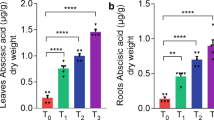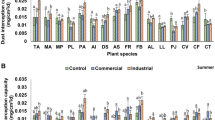Abstract
Continuous addition of undesired effluents to the environment affects foliar surface of leaf, changes their morphology, stomata, photosynthetic pigments, and biochemical constituents which result in massive damage due to persistent nature of the pollutant. In persistent hostile environment, plants fail to grow and develop, and the effects are often extensive. In current study, landscape plants were exposed to different levels of road dust to analyze the effect on various photosynthetic pigments. Dry roadside sediments were collected through a vacuum pump and passed through filters to get fine particles less than 100 μm and sprinkled on Euphorbia milii (EM), Gardenia jasminoides (GJ), and Hibiscus rosa-sinensis (HRs) by using a hand pump, twice daily at T1 (control), T2, T3, and T4 (0, 2, 4, and 6 g/plant, respectively) for a period of 3 months in green house. Road sediment significantly reduces leaf pigments in landscape plants population and the effects were more severe in high level of dust deposition. Individual response of EM, GJ, and HRs to different levels of road dust was variable; however, road sediment significantly reduces leaf pigments at high dose of roadside dust deposition. EM plants exposed to 2 g/plant roadside dust showed higher chlorophyll-a, chlorophyll-b, total chlorophyll, chlorophyllide-b, and polar carotenoid contents as compared to GJ and HRs. Leaf chlorophyll-a, chlorophyll-b, total chlorophyll, carotenoid, and polar carotenoid contents of EM were higher than GJ and HRs in T3 and T4 treatments. However HRs showed significantly higher protochlorophyllide, chlorophyllide-a, and pheophytin-b contents of leaf in T4 group. EM was found as tolerant landscape plant followed by HRs. GJ was most vulnerable to road dust stress. Present study concludes that the entire biosynthesis of leaf pigments is in chain and interlinked together where effect of road dust on one pigment influences other pigments and their derivatives. Salient features of the present study provide useful evidence to estimate roadside dust as a major risk factor for plant pigments, and plants in green belt along roadside suffer retarded growth and fail to establish and develop.













Similar content being viewed by others
References
Ahmad I, Akhtar MJ, Zahir ZA, Jamil A (2012) Effect of cadmium on seed germination and seedling growth of four wheat (Triticum aestivum L.) cultivars. Pak J Bot 44:1569–1574
Allen J, Williams J (1998) Photosynthetic reaction centers. FEBS Lett 438:5–9
Amanullah IA, Irfanullah HZ (2016) Potassium management for improving growth and grain yield of maize (Zea mays L.) under moisture stress condition. Sci Rep 6:34627. https://doi.org/10.1038/srep34627
Armstrong GA, Hearst JE (1996) Carotenoids 2: genetics and molecular biology of carotenoid pigment biosynthesis the. FASEB J 10:228–237
Ebenhöh O, Fucile G, Finazzi G, Rochaix J-D, Goldschmidt-Clermont M (2014) Short-term acclimation of the photosynthetic electron transfer chain to changing light: a mathematical model. Philos Trans R Soc Lond B 369:20130223
Farmer AM (1993) The effects of dust on vegetation—a review. Environ Pollut 79:63–75
Garnier E, Shipley B, Roumet C, Laurent G (2001) A standardized protocol for the determination of specific leaf area and leaf dry matter content. Funct Ecol 15:688–695
Harmut A, Lichtenthaler K (1987) Chlorophylls and carotenoids: pigments of photosynthetic membranes. Method Enzymol 148:350–383
Hayat S, Khalique G, Irfan M, Wani AS, Tripathi BN, Ahmad A (2012) Physiological changes induced by chromium stress in plants: an overview. Protoplasma 249:599–611
Hirano T, Kiyota M, Aiga I (1995) Physical effects of dust on leaf physiology of cucumber and kidney bean plants. Environ Pollut 89:255–261
Holm G (1954) Chlorophyll mutations in barley. Acta Agric Scand 4:457–471
Hörtensteiner S (2006) Chlorophyll degradation during senescence. Annu Rev Plant Biol 57:55–77
Horton P, Ruban A (2004) Molecular design of the photosystem II light-harvesting antenna: photosynthesis and photoprotection. J Exp Bot 56:365–373
Jacovides C, Timvios F, Papaioannou G, Asimakopoulos D, Theofilou C (2004) Ratio of PAR to broadband solar radiation measured in Cyprus. Agric For Meteorol 121:135–140
Jan A, Alam K, Amanullah, Stewart B (2012) Mungbean response to tillage systems and phosphorus management under moisture stress condition. J Plant Nutr 35:21–33
Kahn A, Avivi-Bleiser N, Von Wettstein D (1976) Genetic regulation of chlorophyll synthesis analyzed with double mutants in barley. In: Bücher TH, Neupert W, Sebald W, Werner S (eds) Genetics and biogenesis of chloroplasts and mitochondria. Proceedings of the Interdisciplinary Conference, pp 119–131
Leghari SK, Zaidi M (2013) Effect of air pollution on the leaf morphology of common plant species of Quetta city. Pak J Bot 45:447–454
Liu YJ, Ding H (2008) Variation in air pollution tolerance index of plants near a steel factory: implication for landscape-plant species selection for industrial areas. WSEAS Transactions on Environment and Development 4:24–32
Mandre M, Tuulmets L (1997) Pigment changes in Norway spruce induced by dust pollution. Water Air Soil Pollut 94:247–258
Matile P, Hörtensteiner S, Thomas H (1999) Chlorophyll degradation. Annu Rev Plant Biol 50:67–95
McFeeters RF, Chichester CO, Whitaker JR (1971) Purification and properties of chlorophyllase from Ailanthus altissima (Tree-of-Heaven). Plant Physiol 47:609–618
Mejía Z, Alfonso C, Luengas Pinzón EC, Temprano González J (2013) Influence of traffic in the heavy metals accumulation on urban roads: Torrelavega (Spain)-Soacha (Colombia). Rev Fac Ing Univ Antioquia 32(37):146–160
Myśliwa-Kurdziel B, Strzałka K (2002) Influence of metals on biosynthesis of photosynthetic pigments. In: Prasad MNV, Strzałka K (eds) Physiology and biochemistry of metal toxicity and tolerance in plants. Springer, Dordrecht, pp 201–227. https://doi.org/10.1007/978-94-017-2660-3_8
Neves NR, Oliva MA, da Cruz Centeno D, Costa AC, Ribas RF, Pereira EG (2009) Photosynthesis and oxidative stress in the Restinga plant species Eugenia uniflora L. exposed to simulated acid rain and iron ore dust deposition: potential use in environmental risk assessment. Sci Total Environ 407:3740–3745
Nunes A, Brugnoli E, Maguas C, Correia O (2004) Effect of dust deposition on foliar absorbance of Mediterranean species. Rev Biologia Lisboa 22:143–151
Ong AS, Tee E (1992) [14] Natural sources of carotenoids from plants and oils. Methods Enzymol 213:142–167
Porra R, Thompson W, Kriedemann P (1989) Determination of accurate extinction coefficients and simultaneous equations for assaying chlorophylls a and b extracted with four different solvents: verification of the concentration of chlorophyll standards by atomic absorption spectroscopy. Biochim Biophys Acta 975:384–394
Pružinská A, Tanner G, Anders I, Roca M, Hörtensteiner S (2003) Chlorophyll breakdown: pheophorbide a oxygenase is a Rieske-type iron–sulfur protein, encoded by the accelerated cell death 1 gene. Proc Natl Acad Sci 100:15259–15264
Rai PK, Panda LL (2014) Dust capturing potential and air pollution tolerance index (APTI) of some road side tree vegetation in Aizawl, Mizoram, India: an Indo-Burma hot spot region. Air Qual Atmos Health 7:93–101
Rao M, Dubey P (1990) Explanations for the differential response of certain tropical tree species to SO 2 under field conditions. Water Air Soil Pollut 51:297–305
Reinbothe S, Reinbothe C (1996) Regulation of chlorophyll biosynthesis in angiosperms. Plant Physiol 111:1
Salt DE, Blaylock M, Kumar NP, Dushenkov V, Ensley BD, Chet I, Raskin I (1995) Phytoremediation: a novel strategy for the removal of toxic metals from the environment using plants. Nat Biotechnol 13:468–474
Scartazza A, Di Baccio D, Bertolotto P, Gavrichkova O, Matteucci G (2016) Investigating the European beech (Fagus sylvatica L.) leaf characteristics along the vertical canopy profile: leaf structure, photosynthetic capacity, light energy dissipation and photoprotection mechanisms. Tree Physiol 36:1060–1076
Schelbert S, Aubry S, Burla B, Agne B, Kessler F, Krupinska K, Hörtensteiner S (2009) Pheophytin pheophorbide hydrolase (pheophytinase) is involved in chlorophyll breakdown during leaf senescence in Arabidopsis. Plant Cell 21:767–785
Schoefs B (2000) The light-dependent and light-independent reduction of protochlorophyllide a to chlorophyllide a. Photosynthetica 36:481–496
Shah K, Amin NU, Ahmad I, Shah S, Hussain K (2017) Dust particles induce stress, reduce various photosynthetic pigments and their derivatives in Ficus benjamina: a landscape plant. Int J Agric Biol 19:1469–1474
Simpson DJ, Knoetzel J (1996) Light-harvesting complexes of plants and algae: introduction, survey and nomenclature. In: Ort DR, Yocum CF (eds) Oxygenic photosynthesis: the light reactions. Kluwer Academic, Dordrecht, pp 493–506
Steubing L, Fangmeier A, Both R, Frankenfeld M (1989) Effects of SO2, NO2, and O3 on population development and morphological and physiological parameters of native herb layer species in a beech forest. Environ Pollut 58:281–302
Thompson J, Mueller P, Flückiger W, Rutter A (1984) The effect of dust on photosynthesis and its significance for roadside plants. Environ Pollut A 34:171–190
Udo S, Aro T (1999) Global PAR related to global solar radiation for Central Nigeria. Agric For Meteorol 97:21–31
Wen K, Liang C, Wang L, Hu G, Zhou Q (2011) Combined effects of lanthanumion and acid rain on growth, photosynthesis and chloroplast ultrastructure in soybean seedlings. Chemosphere 84:601–608
White W, Dolphin D (1978) The porphyrins by D Dolphin, vol 5. Academic Press, New York, pp 303–339
Yang C, Chang K, Yin M, Huang S (1998) Methods for the determination of the chlorophylls and their derivatives. Taiwania 43:116–122
Zafra C, Temprano J, Tejero I (2017) The physical factors affecting heavy metals accumulated in the sediment deposited on road surfaces in dry weather: a review. Urban Water J 14:639–649
Zafra Mejía CA, Temprano González J, Tejero Monzón I (2011) Heavy metal concentration and distribution (Pb, Zn, Cu, Cd and Cr) in urban road sediments. Rev Fac Ing Univ Antioquia 58:53–62
Zandalinas SI, Mittler R, Balfagón D, Arbona V, Gómez-Cadenas A (2018) Plant adaptations to the combination of drought and high temperatures. Physiol Plant 162:2–12
Zhang L, Li X, Li X, Wei Z, Han M, Zhang L, Li B (2016) Exogenous nitric oxide protects against drought-induced oxidativestress in Malus rootstocks. Turk J Bot 40:17–27
Author information
Authors and Affiliations
Corresponding author
Ethics declarations
Conflicts of interest
The authors declare that they have no conflict of interest.
Additional information
Responsible editor: Elena Maestri
Rights and permissions
About this article
Cite this article
Shah, K., Amin, N.u., Ahmad, I. et al. Impact assessment of leaf pigments in selected landscape plants exposed to roadside dust. Environ Sci Pollut Res 25, 23055–23073 (2018). https://doi.org/10.1007/s11356-018-2309-3
Received:
Accepted:
Published:
Issue Date:
DOI: https://doi.org/10.1007/s11356-018-2309-3




